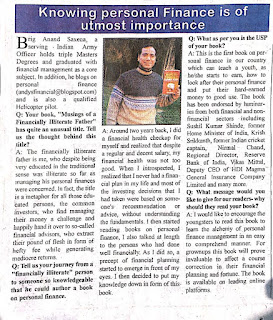Musing 2: Don't Ever Save
MUSING 2: DON’T EVER SAVE
Your
Piggy Bank Eats Money. Let’s say you get attracted
to a real cute dress at H&M (Hennes & Mauritz) at the nearby mall but
don’t have money to buy it because it costs Rs 5000. Your fiscally prudent parents
ask you to save out of your pocket money in order to buy the dress after some
time. So you start saving Rs 500 out of your pocket money each month and keep
putting it in your piggy bank. After 10 months you rush to the H&M outlet
to buy the dress but find that you fall short by Rs 500 since the dress costs
Rs 5500 now. What happened? Did your piggy bank eat Rs 500 over last 10 Months?
Or, the price of the dress went up by Rs 500 in this intervening period?
Actually, it is a bit of both-yes, your piggy bank actually eats money. No
kidding.
What
actually happened was that the purchasing power of your money got eroded by a
phenomenon called Inflation which is
nothing but a rise in prices of goods and services over time. In India we look
at basically two types of Inflations-Wholesale Price Inflation (WPI) and
Consumer Price Inflation (CPI). The WPI compares the wholesale price of a
basket of 697 goods (Manufactured products, food items, fuel and water) month
on month, whereas the CPI compares the price of a basket of 260 items of goods and services at retail customer
level, month on month. We, as common persons should worry about Retail Inflation which is based on CPI. In
India, it is the Monetary Policy Committee (MPC) of the Reserve Bank of India (RBI)
which sets the Inflation targets which are flexible but generally within a range
of 4% plus/minus 2%.
So if the dress at H&M,
which sold at Rs 5000, has gone up to Rs 5500, the inflation is up by 10%.
Simple? Well, all you need to remember is that overtime nearly all the
items/services you will buy or consume will get costlier by amounts corresponding
to Retail Inflation.
The fact
of the matter is that irrespective of how much we earn, it can never make us
rich. We will create wealth only if we can put our saved money to work in a
manner that it keeps generating Real Returns
overtime, meaning returns obtained after catering for Inflation. This brings us
to a very fundamental conclusion-we must put our hard earned/saved money to
work in such a manner that it keeps on giving the value which beats inflation
or in other words one should not merely
save money but instead invest it.
Clearly, your piggy bank cannot
do it. But then what could? We will tackle this question in detail later but
suffice to say at this stage that in India, the rate of Inflation over next
decade is likely to be around 5-6%, as per the forecast of the International
Monetary Fund (IMF). Hence wherever we
invest our money it must give us a rate of return more than 6% or else like our
piggy bank, the money will be eaten. Even
keeping our money in bank Savings account will not be good enough where one
typically gets a return of just 3-4%.
The ubiquitous
Rupee draining power of Inflation gets even more severe in sectors of Real
Estate and education-two areas on top of the mind of every parent and student.
In Mumbai, for example, the price of per square foot of land has gone up by
2205 times in last 55 years. Similarly, the money required to obtain a two year
MBA degree has gone up from Rs 3 Lac in 1999-2000 to nearly 25 Lac today.
Key
Chapter Takeaway
·
The Mantra of saving has to shift to
Investing and wisely too, to beat the Rupee draining power of Inflation.
·
Wherever we invest our money, it must give a rate
of return of at least 6%. The avenues to achieve the same will follow in subsequent
musings.


Very true sir.....waiting for the next musing eagerly
ReplyDeleteAptly brought out , in a very simplistic manner.
ReplyDeleteThe next musing would consolidate it, I'm sure !
...await the same
Yes. Just setting the stage initially
DeleteIt's true jiju n in my views that if someone wants to purchase a thing worth 5000 he/she should save a little bit more money than the calculated amount such that at the end he would have extra money n if the product's price exceeded then also he would have money to save again.
ReplyDeleteVery true Shikha. The ways to do that I'll be covering in subsequent musings. Stay tuned please.
DeleteSure jiju I will
DeleteThank you sir for such an insight . Even for a laymen it is lucrative ☺️.
ReplyDeleteThank Aayush
Deleteit was a nice read.
ReplyDeleteinvestment in cash generating assets generate further cash and that generated cash can be further invested in cash generating assets and this cycle would go on and make u rich
ex: spending money on liquor plant which will generate a cash revenue if successful.
but most people invest in liabilities which does not generate cash and except absorbing it
ex: spending money on buying liquor and unproductive assets.
most people are financial illiterate hence end up investing in liabilities.
Excellent point. I will be covering this in detail in my subsequent musings. Thanks for the input. Will look forward to more interaction.
Deleteamazing! it is really informative and easily understandable by kids of my age.
ReplyDeleteThank you Shreya. Keep following and learning.
DeleteGreat.... Churns out the need to invest. I think this is a must read for all 'kids', financially I mean 😁
ReplyDeleteThanks for following
Delete